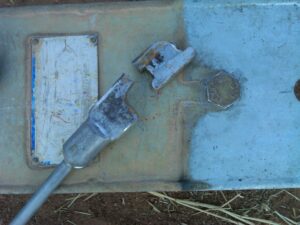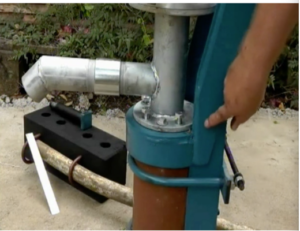Handpumps have revolutionised access to safe, reliable water supplies in low-income countries, particularly in rural areas. They provide a viable alternative to contaminated surface water, open wells and unprotected springs. It is estimated that almost 200 million people in SSA (18.5% of the total population) rely on about 700,000 handpumps to provide them with their main drinking water supply. Handpump reliance is highest in Malawi, South Sudan, Zimbabwe, Guinea and Burkina Faso, ranging from 42% to 61%. The India Mark II pump and the Afridev pump are the two most common community handpumps, while the Vergnet pump is probably the third most common pump. The people of Zimbabwe rely on the Bush Pump.
Published or grey literature in the public domain on handpump component quality is limited, but physical audits undertaken in Burkina Faso in 2013 and 2014, as well as recent studies in Ethiopia, Malawi and Uganda, indicate non-conformance issues in components for between 32% and 90% of samples. While no conclusions over wider prevalence within these four countries or beyond can be drawn from these figures, they do provide a stark warning of potential widespread risk. This is particularly concerning given that participants of the 2021 RWSN groundwater survey expressed concerns about the quality and durability of handpump parts in 13 SSA countries.

Concerns about handpump component quality collated by this study concern riser pipes, pump rods, the steel plate, cylinder assemblies, centralisers, seals, joint to hook or eve, hook, eye, plunger and foot valve, centraliser, head assembly, bearings and flanges – in fact most handpump components. Inexpensive, poor-quality and fake/counterfeit parts, cost-cutting measures and corrosion-related issues were the most common issues cited by respondents to the recent RWSN survey.
Estimates for component life of the Afridev components are available, and the expected fast-moving parts for India Mark handpumps are documented. However, in the three decades of experience of handpump installation since the end of the UN Water Decade in 1990, field data on the service life of handpump hardware and different components remains lacking. This may reflect the lack of asset management and lack of preventative maintenance with respect to handpump technology and services in SSA.

In order to improve the supply chains of spare parts, many countries have standardised on a few public domain and/or propriety handpump models. In the case of public domain handpumps developed for community use, international specifications are available freely in the public domain. However, analysis of the international specifications for the Afridev and India Mark handpumps as well as the Indian Standards for the India Mark pumps reveals five concerns: (i) documents that are difficult to navigate; (ii) errors in the current specifications, including reference to international standards that have been withdrawn; (iii) gaps, particularly in relation to rapid corrosion; (iv) potential difficulties in interpreting the specifications; and (iv) high levels of lead in some of the brass/bronze components.
There have been attempts to improve the design of the India Mark and Afridev handpumps, including making use of modern manufacturing techniques and limited field testing. However, a lack of formal oversight mechanisms for the international handpump specifications, which have essentially been frozen since 2007/8, coupled with very limited interest in funding handpump technology development makes it extremely difficult to address or validate these problems, or to incorporate design innovations.
Guidance is available for quality control and inspection of the Bush Pump, Afridev pump and India Mark pump. More guidance materials are available on quality assurance for the Bush Pump, including manuals in written form for end inspection as well as photo illustrations and videos. Although there are no inspection videos for the Afridev, the guideline document for quality control is detailed and extensive, covering manufacturers, independent inspection agencies and buyers. Unlike the more recently published Bush Pump inspection manuals, the Afridev guidance contains very few photographs. Of the three pumps, the India Mark pump has the least number of guidance materials available to support quality control. The international specifications for the India Mark and Afridev both contain a section on visual and dimensional tests, routine tests and conformity criteria. Short training modules on quality control are also available.

Source: Peter Morgan, Aquamore, Zimbabwe.
The guidelines for quality control and quality assurance of the Afridev provide details on:
(i) internal quality control (for manufacturers);
(ii) external quality control/quality assurance/pre-delivery inspection by an inspection agency; and
(iii) end inspection of delivered goods.
The guidelines also emphasise:
(iv) pre-qualification of suppliers; and
(v) the placement of a clearly defined purchase order.
The 2021 RWSN survey of groundwater pumps found that of the 33 responses by those that buy handpumps directly, there are a diversity of practices, with 33% having no procedures in place. Of the 25 respondents that buy handpumps as part of a borehole drilling package, only 36% stated that they inspect the pump before and after installation, while 48% only inspect the pump before installation and 12% only inspect it after installation. Only one respondent did no inspection. A total of 22 out of 32 respondents (69%) have received feedback or complaints about pump quality, indicating that there are feedback mechanisms in place for some handpump buyers, as well as quality concerns. What was striking in the survey were the variety of opinions, even for the same country of government regulation and activity of regulators, indicating varying levels of awareness and understanding. The Government of Zimbabwe does undertake quality control of the Bush Pump, including inspections at the premises of the manufacturer. In 2020, these inspections raised concerns about various components and resulted in the replacement of non-conforming parts.

Source: Furey and Danert, 2022
Despite the RWSN’s previous long involvement in handpumps since it was established in 1994, very little effort to examine or strengthen handpump supply chains have been undertaken since the mid-2000s. Documentation or knowledge sharing on handpump supply chains appears not to have been undertaken by the World Bank, The United Nations Children’s Fund (UNICEF) or any other organisation operating in SSA or beyond after 2014.
Most handpumps seem to be manufactured in India, with pumps or pump components also imported into SSA from France, the USA and China. There is also manufacture in Zimbabwe and Tanzania. There are at least five links in the supply chain of handpumps or handpump spares – raw materials, handpump manufacture, in-country retailer, drilling contractor, community – and there may be more. There are dozens of handpump manufacturers in India, some of whom claim to be certified by the International Organization for Standardization (ISO). Anecdotal evidence indicates that poor-quality handpumps and components do enter markets in SSA. Given the importance of quality control at point of manufacture, questions remain regarding the responsibilities and activities of the Bureau of Indian Standards (BIS) and factory inspection (if any), the issuing of licences (and potential blacklisting) and incentives to ensure quality of exports.
An ideal supply chain would have quality assurance mechanisms in place at manufacture and a secure tracking of goods throughout, with only certified suppliers allowed to import. However, the case study from Zambia illustrates that this is not the case, with numerous importers and retailers operating, and regulation and quality control procedures are weak or non-existent. According to a small number of stakeholders interviewed, there are both high-quality and poor-quality handpumps available on the market, and capacity among buyers to tell the difference is limited.

Complementing the recommendations from Report II of the Stop the Rot initiative on rapid handpump corrosion, this report recommends that:
- RWSN, other global platforms and funding agencies should:
- Raise awareness and understanding of the important yet under-recognised issue of poor handpump quality with network members and (in the case of funding agencies) grantees.
- Encourage organisations to produce user-friendly guidance in the form of illustrative manuals and videos for ensuring quality, including end inspection by buyers.
- Document and share good procurement practices and feedback mechanisms, including evidence of their effectiveness.
- Encourage investment in raising the capacity of handpump buyers (i.e. governments, drilling contractors, non-governmental organisations and private users) to identify key defects and quality in accordance with specifications and standards.
- Undertake a study to document quality controls at point of manufacture and export from India, including the setting out of responsibilities and activities of the BIS and factory inspection, the issuing of licences and other incentives to ensure quality for export.
- Encourage rigorous research on the expected service life of handpump components, with the results published and available in the public domain.
- Lead international agencies should establish an action group on handpumps (perhaps incorporating other groundwater lifting methods). In addition to the recommendations outlined in Report II (Danert, 2022b), the action group should provide a platform for exchange on mechanisms of improving handpump quality, and could include the issue of brass/bronze components containing high levels of lead. The action group force should also engage organisations that have been working (with very limited funding) to improve handpump design and ensure that handpump manufacturers and standards agencies are brought into dialogue to develop improvements.
- Skat Foundation, which published the international specifications, or another suitable organisation should:
- Republish international handpump standard specifications to address errors and make them more accessible and searchable online.
- Issue recommendations on alternatives to the India Mark handpumps with galvanised iron for areas where there is corrosive groundwater (especially low pH, salinity and chloride), including information regarding experiences, concerns and unknowns about these alternatives to date.
- Develop detailed guidelines for end inspection of India Mark handpumps to include, for example, guidance around component weight and make reference to X-ray dispersive analysis, which is a standard test for measuring coating/plating composition and thickness and other mechanisms.
- National governments should:
- Explore how to start or improve the regulation of handpump imports, in-country fabrication (if appropriate) and in-country supply chains, drawing on examples from other industries. Initiatives should be documented so that others can learn from them.
- Establish an effective feedback mechanism for communities and users to register their experiences of poor handpump quality and use this information in efforts to improve handpump quality.
- Ensure that rehabilitation programmes systematically collect data on the reasons behind handpump failure, including data on hardware problems such as – but not limited to – corrosion.
Explore asset management mechanisms that can incorporate expected component lifetime to support preventative and reactive maintenance programmes, thus helping to alleviate unrealistic burdens on communities.
For more details, you can access the full report: Stop the Rot Report III: Handpump standards, quality and supply chains with Zambia case study. Action research on handpump component quality and corrosion in sub-Saharan Africa’. Ask for Water GmbH, Skat Foundation and RWSN, St Gallen, Switzerland
This is the third of a series of three reports to bring about action to Stop the Rot.
All three reports are also available in French.
